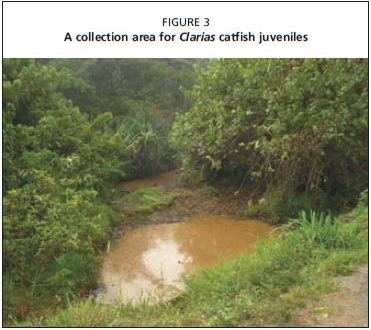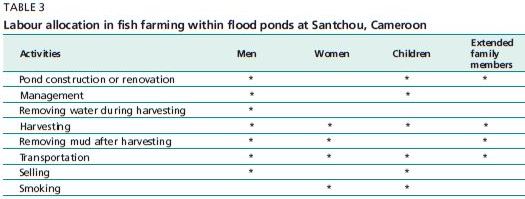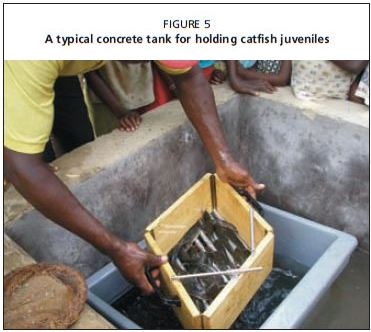DESCRIPTION OF THE FISHING ACTIVITY
Geographic overview of juvenile collection in the Nkam Valley With the flooding of the Nkam and Menoua valleys numerous refuge sites for the young catfish are established in the nearby lowland farms (Figure 3). In addition to fishing for juvenile
Figure 3
A collection area for Clarias catfish juveniles

clariids, there is also a traditional practice of extensive fish farming of catfish in flooded ponds. The main villages concerned with the fishery for juveniles and the catfish aquaculture include Lelem, Ngang, Santchou and Fongwang. Ngang Island is particularly well known as a good fishing ground.
Fishing gear and materials used for the collection of Clarias juveniles
Fishing materials are generally artisanal and consist of 10 to 30 litre buckets, gasoline water pumps for draining water from the fishing grounds, hand nets, seine nets, cast
Figure 4
Fishing basket (right) and a two-wheel carrier used for transporting juvenile fish (left)

nets and baskets used to catch the juveniles. Materials for transporting the catch from the fishing sites to the market includes 10–40 litre plastic or aluminium containers, canoes, bicycles, and wheelbarrows. (Figure 4).
Production statistics
Data on fishery production has not been regularly collected. Current estimates indicate values of 7.5 and 1.1 tonnes per year for Clarias jaensis and for Clarias gariepinus, respectively (Mfossa, 2007). Forty percent of the production consists of juvenile catfish averaging 10–40 grams in weight for potential use in aquaculture (approximately 0.3 million Clarias jaensis and 0.04 million Clarias gariepinus). National data indicate that the total freshwater aquaculture fish production in 2006 was 870 tonnes, of which 330 tonnes consisted of Clarias gariepinus (Pouomogne, 2007b).
Seasonality of fishing activities
Fishing begins in mid-November with the retreat of the water from the valley. The fishery usually continues until late March of the following year and stops with the arrival of the new rainy season. Professional fishers continue fishing throughout the year in other locations during the rainy season when heavy flooding precludes safe fish capture activities in the valley.
Fishing sociology – tribe, gender, division of labour
The Mbo, the indigenous people of the valley, are the main ethnic group involved in the fishery for juveniles and have ancestral rights to most fishing grounds. In Lelem village, the people of the Bamileke tribe own some farm areas in the lowlands where fishing for catfish juveniles can be undertaken.
Men, women and children all actively participate in the fishing, care of the flood ponds and harvesting activities. Men are particularly engaged in pond construction, management and harvesting, as such activities demand hard labour. Women are more involved in activities such as the distribution of the fish to the various destinations and smoking of the fish. Selling of the fish is mostly a male responsibility (Table 3).
Handling and holding
The distance from the fishing ground to the fisher’s home, to the flood ponds and to the market varies from 0.5 to 15 kilometres. As mentioned above, juvenile Clarias are transported to the fish ponds by canoe, wheelbarrow or bicycle. When the destination is outside the valley, cars are used, e.g. for delivery to Kumba which is >300 kilometres
TABLE 3
Labour allocation in fish farming within flood ponds at Santchou, Cameroon

Source: Che, 2007.
away. Prior to transport, the wild
Figure 5
A typical concrete tank for holding catfish juveniles

seed are kept in 100 litre containers, or in earthen or concrete tanks for up to a month (Figure 5). Water is renewed 1–2 times per day. Fish are fed on corn flour, with care to avoid over-feeding and deterioration of water quality.
In addition to the problems related to cannibalism and stocking fingerlings of similar sizes, key factors determining survival are the renewing of water twice daily and ensuring sufficient accessibility to air for the fish (i.e. use of a wider shallow container, rather than deep one). Another cause of high mortality after stocking appears to be related to the condition in which the fishing was performed. When fingerlings spend an abnormally long time in the mud during the draining and catching process, up to 100 percent mortality may occur.